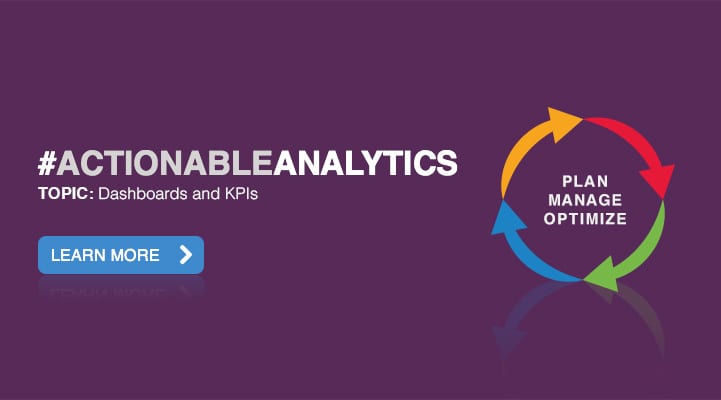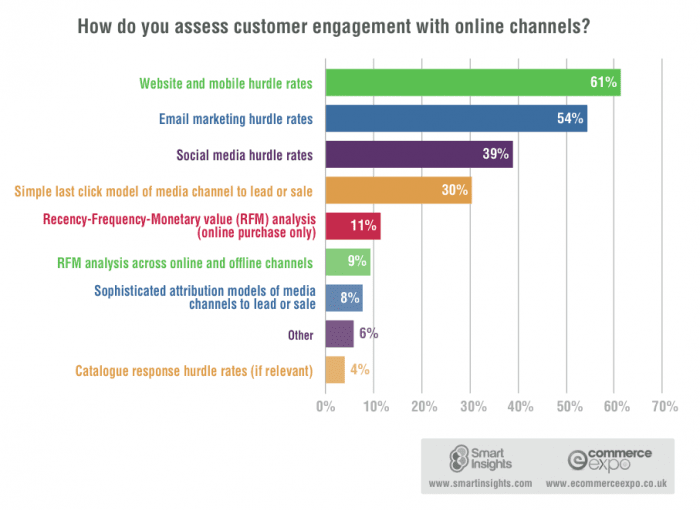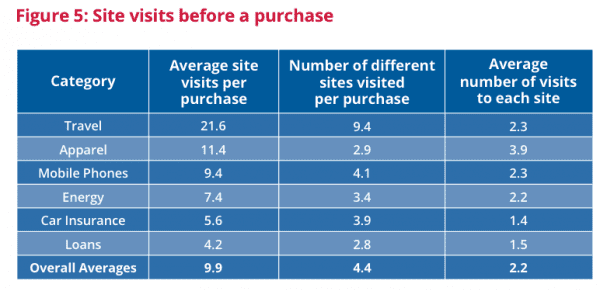It looks cool, but how should you use insights from attribution to improve media spend?

With the growing maturity in analytics tools and the geniuses at Google and other analytics services working to improve them, it is great to see attribution modelling data and insights now widely available. But availability of these tools doesn't equal use, indeed the Smart Insights Customer Experience Management report shows that while we're pretty good at reviewing engagement with websites, email and social media through hurdle rates, the use of attribution is languishing way down at the bottom of methods of assessing engagement.

[Editor's note: To help shed some light on the what-why-how of attribution modelling and as part of our mission to make analytics more actionable, we asked Hugh Gage to write a guide on how to use attribution modelling which is now available for Expert members].
Looking beyond ROI
In this article and a follow-up I will explore the different opportunities that adopting an attribution mindset and data open up. I, for one, love a commercial, ROI-driven approach to marketing. However, although attribution reports and analysts may do a great job at modelling how your marketing spend is performing, as a marketer you need to know the right questions to ask and how to interpret the output from attribution.
What rarely happens, it seems, is that the data and insights directly fuels planning and ideas sessions in an engaging way to arrive at suite of actions and tests. I would like to question your previous thought process and ask whether attribution or reviewing analytics made any difference… Did you turn off channels you feel you maybe shouldn’t? Do you feel like it should work but not used in the right way or have the right weighting...
Not all channels are made the same
Thinking back to my time when working client side where I was actively involved in the modelling and marketing planning, I remember display and affiliate marketing investment always coming into question, based purely on data… Our travel product at the time had a 3-month research > purchase lifecycle and therefore the tool configuration we had (then Omniture in 2006) was reporting on last click wins only. Research by Google shows how visitors rarely purchase on first click in many sectors and you can see there is a particular challenge in travel.

So, back to our story, for us, affiliates primarily utilised display advertising and generic PPC terms, meaning they were actually helping us capture the attention of people very early in the buying cycle, people we would have unlikely captured in our marketing. We had to engineer our site and lead tools towards those channels so that we could ensure we could nurture the relationship appropriately to generate the sale over time. As Seth Godin would say “You don’t ask a girl to marry you on the first date!”. We later used attribution to consider media investments across the buying process or if you prefer the McKinsey Loyalty Loop.
Channels that help create Awareness
Let's start at the very top of the funnel, where traditional advertising used to excel. A lot of channels can be used to generate awareness and naturally, it is where most marketers put most of their spend, time and energy. By applying attribution, the single biggest mindset change for awareness based channels is what success should look like (back to my Seth quote previously).
Key channel types which generate Awareness
- Social media advertising - Allows you to be uber specific on who you are targeting with specific messages
- Display advertising - partnerships or display networks based on audience interests
- Search marketing - Non brand PPC and SEO- Category / industry specific keywords
- Online PR - including outreach to influencers and partner sites
- Affiliate marketing - although can have an impact further down the funnel
Success examples
- Visit to the website (cookie to retarget)
- Basic data sign up / Like / Follow
If you're not using attribution you may well miss the value these type of media channels are generating since these will often generate a "first-click" through to the site rather than a "last click" which is what Google Analytics reviews by default.
Channels that help develop Consideration
So the customer is aware of you, likely of a few of your competitors too! Engaging that consumer in way which helps them start to trust your brand so you can earn the right to sell is crucial at this point. The intensity of your marketing at this point is completely dependant on your business model and customer relationships. This is where you can have loads of fun I think especially in the content you create to fuel your channels.
Key channel examples:
- Brand search
- Natural search
- Re-targeting advertising
- Social media outposts
Success examples
- Lead tool sign up
- Product page view
Channels that drive Purchase
Driving purchase whether online or offline is ultimately what we all have to do. There are some channels that work unbelievably well for this, most of which I hope are obvious! While the channels are obvious the complexity in their configuration and content requirements is what makes these channels time and resource heavy.
Key channel examples
- Email marketing
- Social media
- Outbound texts / phone calls
Success examples
Channels that encourage Advocacy
The ultimate way to build a business is to continue to create and sell remarkable things to those that have already bought from you and they then share! Easier said than done right? Email marketing can be highly effective here and social media to a lesser extent. With attribution you can see where recommendations from existing customers encourage first contact with new customers. It amazes me that so-called "social media gurus" never discuss attribution since it is one of the best ways of proving social media ROI, or otherwise...
Key channel examples:
- Email marketing
- Social media
- Re-targetting
Success examples
- Repeat visit to the website / open an email
- Content share
- Repeat purchase
- LTV increase
- Referral
Making this useful…. “Checking In with your data”
A really useful way to utilise your data to spot opportunities is to have a live screen with your analytics software on-screen and create various segments / scenarios where you can validate the following things in a mini workshop (a good old whiteboard is always useful too)
- Are you using the right channels to support the right customer engagement goals at different points in the funnel?
- Is the message / content you are showing to people from each channel and at each stage as specific as it could be?
- Are there simple trials you could run to try engineer more sales from either the channel mix?
I hope this post shows some reasons why media attribution should get more attention! In the next article we will explore how attribution data and even just the mindset outlined above can aid business and campaign planning.










